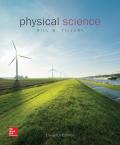
Concept explainers
Two outcrops separated by a distance of 32 km are exposed in a region. The fossils occurring in the region are listed in the following table:
Fossil |
Age Range |
A |
Early Triassic through Cretaceous |
B |
Jurassic through Miocene |
C |
Late Jurassic through Cretaceous |
D |
Oligocene through Pliocene |
E |
Pliocene through Pleistocene |
Outcrop 1 has a shale layer that contains fossil A overlain by a limestone with fossils B and C. Outcrop 2 has a shale layer that contains fossil C overlain by a red sandstone with fossils D and E. Which layers can be correlated between outcrops and what is the age of the layers?
Trending nowThis is a popular solution!

Chapter 21 Solutions
EBK PHYSICAL SCIENCE
Additional Science Textbook Solutions
Cosmic Perspective Fundamentals
Introductory Chemistry (6th Edition)
Microbiology Fundamentals: A Clinical Approach
Human Physiology: An Integrated Approach (8th Edition)
Fundamentals Of Thermodynamics
Chemistry & Chemical Reactivity
- Give an example of friction speeding up an object.arrow_forwardWhich is the higher temperature? (Assume temperatures to be exact numbers.) (a) 272°C or 272°F? 272°C 272°F They are the same temperature. (b) 200°C or 368°F? 200°C 368°F They are the same temperature.arrow_forwardWhat is the direction of a force vector given by ~v = −6Nˆi − 8Nˆj?arrow_forward
- What can be said of the position vector of an object far from any influences on its motion?arrow_forward་ Consider a ball sliding down a ramp as shown above. The ball is already in motion at the position 1. Which direction best approximates the direction of acceleration vector a when the object is at position 2?arrow_forwardPlease solve and answer the question correctly please. Thank you!!arrow_forward
- Please solve and answer the problem correctly please. Thank you!!arrow_forwardPlease solve and answer the problem correctly please.Thank you!!arrow_forwardProblem Eight. A snowmobile is originally at the point with position vector 31.1 m at 95.5° counterclockwise from the x-axis, moving with velocity 4.89 m/s at 40.0°. It moves with constant acceleration 1.73 m/s² at 200°. After 5.00 s have elapsed, find the following. 9.) The velocity vector in m/s. (A)=-4.38+0.185ĵ (D) = 0.185 +4.38ĵ (B)=0.1851-4.38ĵ (E) = 4.38 +0.185ĵ (C) v=-0.1851-4.38ĵ (A)=-39.3-4.30ĵ 10.) The final position vector in meters. (B)=39.3-4.30ĵ (C) = -4.61 +39.3ĵ (D) = 39.31 +4.30ĵ (E) = 4.30 +39.3ĵarrow_forward
 An Introduction to Physical SciencePhysicsISBN:9781305079137Author:James Shipman, Jerry D. Wilson, Charles A. Higgins, Omar TorresPublisher:Cengage Learning
An Introduction to Physical SciencePhysicsISBN:9781305079137Author:James Shipman, Jerry D. Wilson, Charles A. Higgins, Omar TorresPublisher:Cengage Learning AstronomyPhysicsISBN:9781938168284Author:Andrew Fraknoi; David Morrison; Sidney C. WolffPublisher:OpenStax
AstronomyPhysicsISBN:9781938168284Author:Andrew Fraknoi; David Morrison; Sidney C. WolffPublisher:OpenStax


